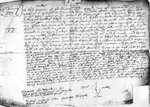| |
Will re Southfields,
Dedham, [D/ABW 8/80] &
AGNES WODD
of Southfield House in Dedham widow. 21 November 1583. [For John Wood
clothier, see Volume IV, p. 320]. [BW 40/37]
| |
To Richard
my son these rooms in my house in Dedham, i.e., the great parlour,
two butteries with two cellars under them, the hall, the weighing
house, the burling shop, together with the parlour sollars and
all the other sollars over the said rooms on the west side of
the great messuage called commonly the Southfield House unto the
gatehouse or gallery, and the gatehouse and chamber over the same.
To him also South Field (containing 10 acres) and another close
(3 acres) adjoining the messuage on the west part, and a barn
standing in the gravel pit, with a parcel of ground in the field
where the barn standeth (11/2 roods) for a way for him and his
assigns to and from the barn, together with the now usual way
from the barn field to the messuage, also the gardens from the
said way lying about his part of the house; Richard to have his
and their entrance, egress and regress into and from his part
of the said rooms through the usual south gate of the messuage
leading and being over the cellar belonging to John my son; together
with half the yard room lying between Richard's and John's parts
of my said tenement.
To John
all the other rooms of my house, i.e. the little parlour, the
cellar under it, the chamber over it, and all other the houses
and rooms from the chamber and parlour on the south side and east
part of my said capital messuage to the gatehouse on the north
side of the said messuage; also free egress, regress and liberty
to John through the gatehouse; and half the yard room between
Richard's and John's parts; with the barn, stable, cotes, outhouses,
yard rooms and orchards and all other the lands, meadows and pastures
to the capital messuage belonging. Upon condition that John shall
not molest or claim as heir to his late father any title unto
Southfield given to Richard in this my testament, and if he do
so to lose and forfeit his whole legacy and portion to Richard.
To Richard
the bedstead, table, painted cloths and portal in the great parlour
and the painted cloths hanging alongst the long table there. To
John a trundle bedstead. The residue of my goods, ready money
and movables unbequeathed shall be divided into two equal parts,
Richard to have one and John the other.
To Edmund
Browne my daughter's son £6 13s. 4d. at 23. To Agnes Browne my
said daughter's daughter £3 6s. 8d. at 20. Provided always that
my tenant George Bygges shall quietly have and enjoy the capital
messuage, houses, lands and commodities for 7 years yet to come
from Michaelmas last according to a lease of the date hereof without
any let or interruption of Richard and John, their executors or
assigns, anything in this my testament notwithstanding.
I make
Richard and John executors, charging them to agree and live together
like brethren in unity and peace. In case any ambiguity arise
between them, they shall be decided by the good discretions of
my trusty friends Richard Clarke the younger and George Bygges
of Dedham, whom I ordain overseers.
To widow
Durraunt 3s. 4d. and widow Aylmer 6s. 8d.
Witnesses:
Ralph Kinge, Richard Clarke the elder, Richard Clarke junior,
George Bigges.
|
| [Emmison, F. G., Elizabethan Life: Wills
of Essex Gentry and Yeomen, (1980), p.160] |
Southfields is
a fine half-timbered building with a courtyard plan and is connected
by tradition with the cloth trade. It is said to have been 'a bays and
says factory'.23
The will of Agnes Wood, widow of clothier John Wood of 'Southfields
House', 21 November 1583 ties this fine property to the cloth trade.
On line 12 is mentioned the weighing house and 'burling', which the
Oxford English Dictionary defines as 'the dressing of cloth, especially
by removing knots' and dates an early reference to the burling of cloth
to 1530.
Though the woollen
industry had existed in Essex at least since the C13th, it was the 'new
draperies' of the sixteenth century which brought a prosperity to Essex
towns and villages to rival the profits from agriculture. The new draperies
were introduced to Essex by refugees from the Spanish persecutions in
the low countries. The first considerable 'Flemish' arrivals in Colchester
came by way of Sandwich probably in 1570-1571. 'Bays' and 'says' were
lighter than the Essex or Suffolk broad cloths and far more economical
in wool. The 'say' which became the chief product in Colchester at one
time was a short light cloth used for shirts and linings. 'Bays' were
also 'thin light cloths, but finely woven and un-ridged, one side was
sheared and cottoned with hot irons while the other was smooth and retained
a long nap'.24
In 1571 there were 185 aliens in the town of Colchester, of whom 177
were 'Dutch'. By 1586 a head count showed a remarkable increase to 1278
strangers. The 'Dutch Congregation', for they were allowed their own
church, were granted a charter and the privy Council despatched letters
to the town recommending that these strangers should be favoured and
cherished since the town had benefited so greatly from the new draperies,
[Acts of the Privy Council, 1601-4, 31 December 1603]. The 'Dutch' quarter
of Colchester which clustered around West and East Stockwell Street
remains a feature of tourist trails around the town tothis day.
|
|
|
Will re: Southlands, Dedham
|
|
|


